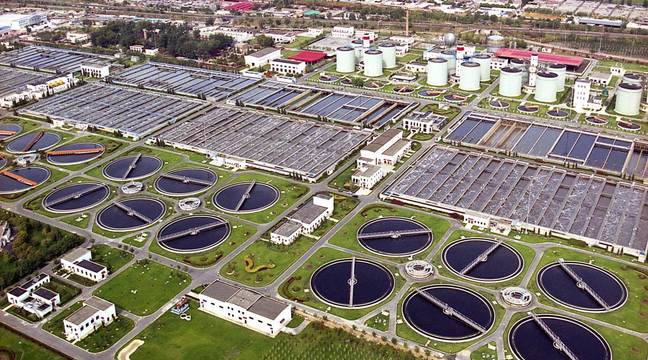
当前课程知识点:Water and Wastewater Treatment Engineering: Biochemical Technology > Chapter 0 Introduction > Section 0.2 Typical Processes of Wastewater Biological Treatment > Section 0.2 Typical Processes of Wastewater Biological Treatment
返回《Water and Wastewater Treatment Engineering: Biochemical Technology》慕课在线视频课程列表
返回《Water and Wastewater Treatment Engineering: Biochemical Technology》慕课在线视频列表
这是在北京市高碑店污水处理厂的一个全景的图片
我们可以看到这是一个处理能力为
100万吨每天的大型的城市污水处理厂
前面有初沉池,中间有曝气池,后面圆形的是二沉池
通过这样的一个工艺进行处理以后
废水就能够达到刚才我们说的这样的一个排放标准
能够使废水得到净化
当然在世界上,有很多的各种规模、各种类型的城市污水厂
在这看到的是德国的一个污水处理厂
可以看到它不仅有这个城市污水处理
在河的对面,有一小块是它的这个工业污水处理厂
将工业污水经过一定的预处理之后
再跟城市污水混到一起进行处理
在这个城市污水处理厂中间
它还有一个很有特点的是
二沉池的污水还经砂滤池经过过滤以后
才排到这个污水厂旁边的河道
另外在这个污水厂中,还有污泥焚烧厂
它的污泥经过脱水之后直接焚烧
另外我们也会看到,在德国的另外的一个污水处理厂
在这个污水厂中间
它的二沉池也采用的是平流式的二沉池
所以我们看不到圆形的池子
它的处理一定的工业污水、处理一定的城市污水
也有污泥处理和污泥焚烧
同时还有典型的卵形的污泥厌氧消化池
这是在城市污水厂中间最重要的、最核心的曝气池
我们可以看到表面有通过微孔曝气以后产生的一些气泡
在曝气池中间,其实最重要的是这个混合液
混合液中间,之所以把它称为混合液
是因为有活性污泥跟废水的混合
这边量筒中间,我们看到
典型的曝气池中间的混合液是这种黄褐色的
在曝气池的底部,更重要的是有为微生物好氧微生物提供氧气的曝气系统
曝气系统,当然是由鼓风机加上空气管道,加上最后的微孔曝气头
旁边给出的这个图片,就是这个微孔曝气头
可以将空气切割成非常细的气泡
有利于空气中的氧向水中转移
在活性污泥中间当然最重要的是微生物
这是我们前面也提到过的
废水生物处理中的生物,实际上特指的是微生物
在这给的一张典型图是活性污泥的菌胶团
在这个菌胶团中间,还有很多的这种原生动物
像盖纤虫,钟虫,草履虫和变形虫
我们可以看到,在这个菌胶团中间
还会有一些更高级一点的后生动物,像线虫和轮虫
在后面,我们以后也专门来介绍
在活性污泥系统中间,原生动物和后生动物,主要是作为这个指示生物
它能够指示这个活性污泥的状态,能够指示曝气池运行时的工况
不同种类的原生动物或者后生动物出现
是跟这个水质和跟它的运行工况有关的
当然,实际上在活性污泥菌胶团中真正起降解作用的
或者是主要起降解作用的,是其中的细菌
但是我们在这样的放大倍数下,是看不见的
因此的话,我们可以看到,在废水生物处理中间
所涉及到的微生物,主要分成非细胞形态的微生物,像病毒和噬菌体
当然,这些东西我们肉眼很难观察到
另外就是细胞形态的一些微生物
这中间,又分为原核生物和真核生物
原核生物中间分成细菌,细菌又分成真细菌和古细菌
以及跟细菌平行的还有放线菌和其它的一些蓝藻,或者说是蓝细菌
在真核生物中间,有真菌、藻类以及原生动物和后生动物
下面我们来介绍一下城市污水处理排放标准及工艺的变化
可以看到,从1973年开始,中国出台了第一个废水处理的排放标准
是GBJ4-73
随后,在1988年,我们又出了新的标准
到1996年,我们又出了标准
2002年(又推出了新的标准),目前,我们绝大多数的水厂
执行的是这个GB18918-2002的这个标准
分成一级B、一级A,以及二级的标准
我们可以看到,这个标准的变化,它要求的
不仅是要求的这个污染物的指标增加
而且这些数值都越来越严格
那么这样一个标准的变化,对我们污水处理流程有什么样的影响
我们可以看到,在最开始如果是达到前两个标准的话
我们用这样的一个简单的工艺流程就可以到达
也就是通过格栅,通过沉砂池,再加上初沉池和曝气池、二沉池
这样一个标准的、比较简单的污水处理的流程就可以达到标准
但是,如果我们要求其中的氨氮要达到一定的排放标准的话
我们就需要在曝气池中间增加一个专门的硝化池
曝气池的池容会有增加
如果有总氮的要求,我们就需要进行反硝化
我们要增加一个缺氧池
同时,还需要把后续好氧池的硝化液
通过回流回到缺氧池
所以我们不仅要增加一个池,还要增加一个硝化液的回流
如果对总磷或者是磷酸盐排放有要求的话
我们就需要增加一个厌氧池
而且,还需要增加一个回流,使这个厌氧生物除磷的功能得以发挥
因此,我们可以看到,如果有除磷的要求
我们还会增加一个池
我们也看到了后续的排放标准,特别是一级A的标准的要求
要求出水的悬浮物SS要小于10mg/L
我们通过这个重力沉淀二沉池,可能就达不到这样的标准
所以我们在后期,可能需要增加一个砂滤池
这个滤池,是黄老师在前段已经介绍了滤池
主要是用来去除水中间的悬浮物,增加这样的一个滤池以后
我们就能够确保出水SS达到这个10mg/L以下
并且为了保证磷酸盐更好的达标,像一级A要求总磷的标准是的0.5mg/L
有的时候在滤池之前,还需要增加化学药剂
现在在很多排放标准是一级A的污水处理厂
就会用到这样一个完整的流程
我们可以看一下,跟最初的这个流程相比
这个完整的流程,我们增加了很多的内容
我们增加了硝化池,增加了缺氧池,增加了生物处理的厌氧池
还增加了后续过滤的砂滤池,甚至还增加了化学药剂的投加
因此,在城市污水处理厂中间,我们会看到
会分成一级处理、二级处理、或者是三级处理
那么所谓的一级处理那,实际上是指采用简单的一些物化处理的工艺
对废水进行简单的处理,或者是预处理
主要,在流程图中间看到是到初沉池为止
那么基本上是经过这个格栅,沉砂和初沉
二级处理,是指在一级处理的基础上
增加了这个生物处理的工艺,即曝气池和二沉池
它的出水标准会比一级要好很多
但是,我们通过简单的这个生物处理以后
可能还不能达到比较高的标准
有的时候,我们就需要增加这个三级处理
实际上是指在生物处理之后,对二沉池的出水进行深度处理
使它的悬浮物、使它的有机物
甚至使它的总磷,含有一些微量有机物都能够得到去除
所以,我们在城市废水处理的程度上
我们简单来分,可以分为三类
一类是一级处理,一类是二级处理,一类是三级处理
废水生物处理的工艺,可以分成很多类别
我们简单的来分,可以分成天然的生物处理工艺和人工的生物处理工艺
天然的生物处理工艺,主要分为生物稳定塘和土地处理系统
人工的生物处理工艺,可以分成好氧生物处理工艺和厌氧生物处理工艺
在好氧生物处理工艺中间,我们又可以分成活性污泥工艺以及好氧生物膜的工艺
在厌氧生物处理工艺中间
可以分为传统厌氧硝化,以及现代高速厌氧反应器
本课程的主要内容一共有九章
除绪论以外,我们首先介绍废水生物的处理基本原理
然后,用三张来介绍好氧生物处理工艺
分别介绍活性污泥法、生物膜法和其它好氧工艺
然后第五章,介绍厌氧生物处理工艺
第六章,介绍营养元素的生物去除,实际上是指生物脱氮和生物除磷
第七章,介绍天然条件下的生物处理
第八章介绍污泥的处理与处置
第九章,介绍废水的深度处理、回用与排放
本课程的教材,是有四本
第一本是张自杰先生的《排水工程》
第二本,是顾夏声先生的《水处理工程》
第三本,是《Wastewater Engineering - Treatment and Reuse》
第四本,是钱易老师的《现代废水生物处理新技术》
这节的内容就到这,谢谢!
-Section 0.1 Development Status of Wastewater Treatment Process
--Section 0.1 Development Status of Wastewater Treatment Process
-Section 0.2 Typical Processes of Wastewater Biological Treatment
--Section 0.2 Typical Processes of Wastewater Biological Treatment
-Section 1.1 Principles of wastewater aerobic biological treatment
--1.1 Principles of wastewater aerobic biological treatment
-Section 1.2 Principles and determination of wastewater biodegradability
--1.2 Principles and determination of wastewater biodegradability
-Section 1.3 Principles of wastewater anaerobic biological treatment
--Section 1.3.1 Principles of wastewater anaerobic biological treatment(1)
--Section 1.3.2 Principles of wastewater anaerobic biological treatment(2)
-Section 1.4 Principles of wastewater biological nitrogen removal
--Section 1.4 Principles of wastewater biological nitrogen removal
-Section 1.5 Principles of wastewater biological phosphorus removal
--Section 1.5 Principles of wastewater biological phosphorus removal
-Chapter 1 Homework
-Section 2.1 Basic concept of activated sludge process
--Section 2.1.1 Basic concept of activated sludge process
--Section 2.1.2 Basic concept of activated sludge process
-Section 2.2 Growth rule of activated sludge and its application
--Section 2.2 Growth rule of activated sludge and its application
-Section 2.3 Running mode of activated sludge process
--Section 2.3.1 Running mode of activated sludge process(1)
--Section 2.3.2 Running mode of activated sludge process(2)
-Section 2.4 Kinetics of active sludge process
--Section 2.4.1 Kinetics of active sludge process(1)
--Section 2.4.2 Kinetics of active sludge process(2)
--Section 2.4.3 Kinetics of active sludge process(3)
--Research and Development of Kinetic Model of Activated Sludge Process
-Section 2.5 Principle, calculation and equipment of aeration
--Section 2.5.1 Principle, calculation and equipment of aeration(1)
--Section 2.5.2 Principle, calculation and equipment of aeration(2)
-Section 2.6 Designing of activated sludge process
--Section 2.6 Designing of activated sludge process
-Section 2.7 Operation and management of active sludge process
--Section 2.7.1 Operation and management of active sludge process (1)
--Section 2.7.2 Operation and management of active sludge process (2)
-Chapter 2 Homework
-Section 3.1 Basic principle of biofilm
--Section 3.1 Basic principle of biofilm
-Section 3.2 Biofilter process
--Section 3.2.1 Biofilter Process (1)
--Section 3.2.2 Biofilter process (2)
--Section 3.2.3 Biofilter process (3)
-Section 3.3 Biodisk process
-Section 3.4 Biological contact oxidation process
--Section 3.4 Biological contact oxidation process
-Section 3.5 Aerobic biological fluidized bed process
--Section 3.5 Aerobic biological fluidized bed process
-Chapter 3 Homework
-Section 4.1 Oxidation ditch process
--Section 4.1 Oxidation ditch process
-Section 4.2 A-B process
-Section 4.3 SBR process
-Section 4.4 MBR process
-Chapter 4 Homework
-Section 5.1 Overview and characteristics of development of anaerobic biological treatment
--Section 5.1 Overview and characteristics of development of anaerobic biological treatment
-Section 5.2 Anaerobic digester
--Section 5.2 Anaerobic digester
-Section 5.3 Anaerobic contact process and anaerobic filter process
--Section 5.3 Anaerobic contact process and anaerobic filter process
-Section 5.4 UASB process
-Section 5.5 Other anaerobic biological treatment process
--Section 5.5 Other anaerobic biological treatment process
-Section 5.6 Operation management of anaerobic biological treatment process
--Section 5.6 Operation management of anaerobic biological treatment process
-Chapter 5 Homework
-Section 6.1 Introduction
-Section 6.2 Biological nitrogen removal process and technology
--Section 6.2 Biological nitrogen removal process and technology
-Section 6.3 Biological phosphorus removal process and technology
--Section 6.3 Biological phosphorus removal process and technology
-Section 6.4 Simultaneous nitrogen and phosphorus removal process
--Section 6.4 Simultaneous nitrogen and phosphorus removal process
-Chapter 6 Homework
-Section 7 Natural biological treatment process
--Section 7 Natural biological treatment process
-Chapter 7 Homework
-Section 8.1 Source, nature and treatment of sludge
--Section 8.1 Source, nature and treatment of sludge
-Section 8.2 Sludge thickening and digestive stability
--Section 8.2 Sludge thickening and digestive stability
-Section 8.3 Sludge conditioning, dehydration and incineration
--Section 8.3 Sludge conditioning, dehydration and incineration
-Chapter 8 Homework
-Section 9 Wastewater Discharge and Reuse
--Section 9 Wastewater Discharge and Reuse
-Chapter 9 Homework
